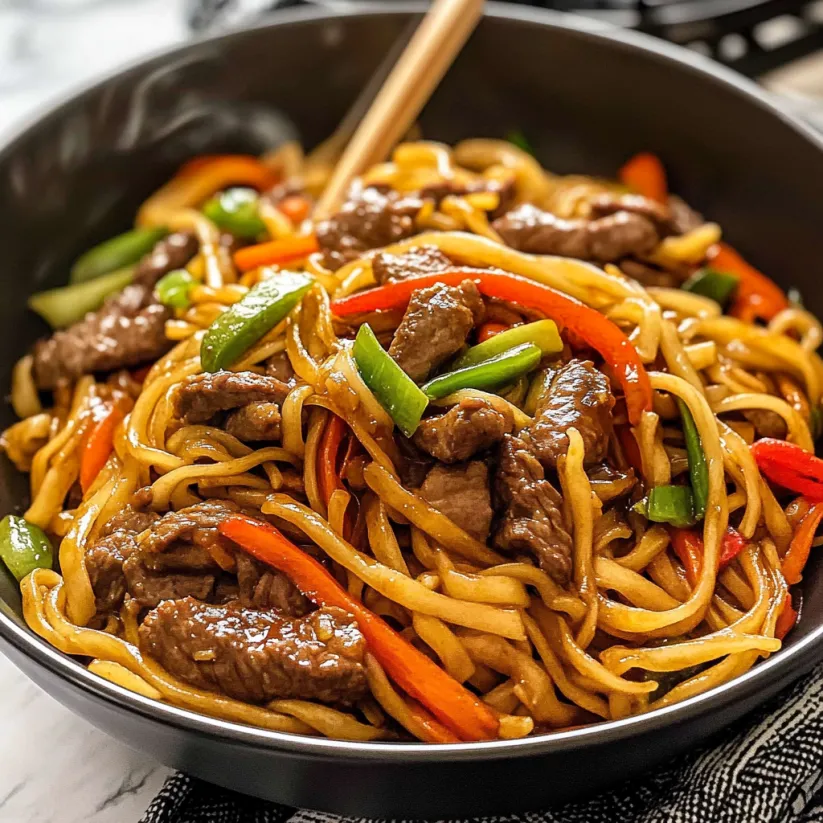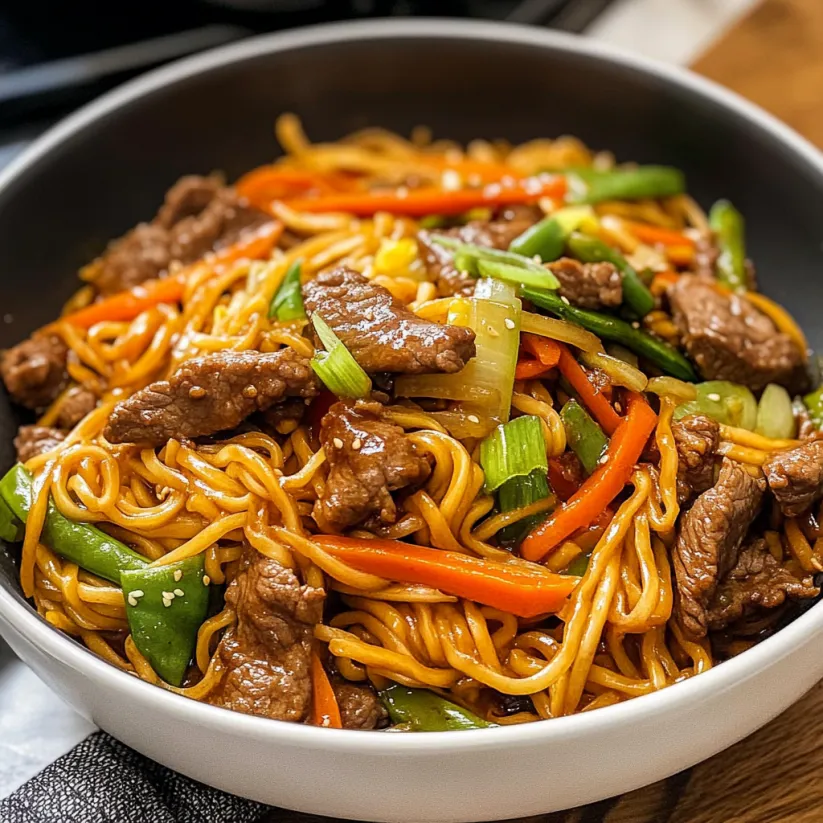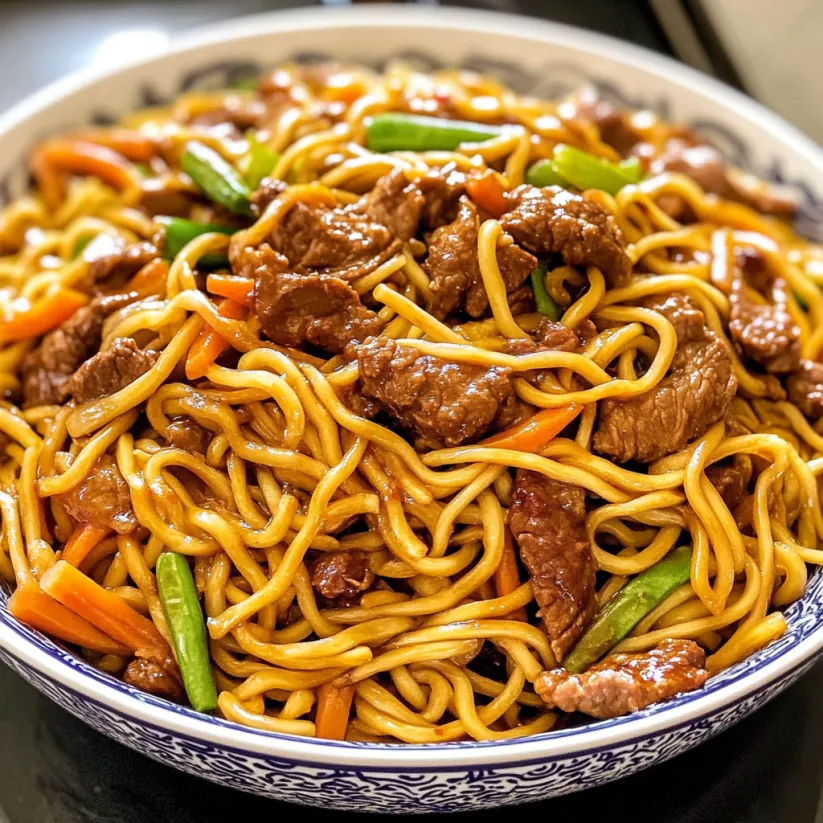 Save Pin
Save Pin
This beef lo mein has been my weeknight dinner savior for years, combining tender strips of flank steak with colorful vegetables and slurp-worthy noodles all tossed in a rich, savory sauce that will make you forget about takeout forever.
I first created this recipe when my family was craving Chinese food during a snowstorm. What started as a pantry cleanout meal has now become our most requested dinner when guests come over.
Ingredients
- Flank steak: Thinly sliced against the grain ensures tender results every time
- Cornstarch and baking soda: Create velvety tender meat through a quick marinade
- Low sodium soy sauce: Provides saltiness without overwhelming the dish
- Dark soy sauce: Adds beautiful color and rich depth of flavor
- Oyster sauce: Brings that signature umami taste that makes lo mein authentic
- Shaoxing wine: Adds complexity that regular cooking wine simply cannot match
- Lo mein noodles: Provide the classic chewy texture, look for egg noodles if possible
- Variety of vegetables: Creates texture contrast and nutritional balance
Step-by-Step Instructions
- Prepare the Noodles:
- Cook the lo mein noodles according to package directions until they are just al dente. Be careful not to overcook as they will continue cooking when added to the wok. Rinse with cold water immediately after draining to stop the cooking process and prevent sticking.
- Marinate the Beef:
- Combine the flank steak strips with soy sauce, cornstarch, peanut oil, and baking soda in a bowl. The baking soda is crucial here as it tenderizes the meat by breaking down proteins. Allow it to marinate for at least 10 minutes while you prepare other ingredients.
- Create the Sauce:
- Whisk together brown sugar, both soy sauces, oyster sauce, white pepper, Shaoxing wine, and sesame oil until completely combined. This balanced mixture brings sweet, salty, and umami elements that define great lo mein. The sauce should look glossy and smell fragrant.
- Sear the Beef:
- Heat your wok or large skillet until nearly smoking then add peanut oil. Spread the marinated beef in a single layer and let it sear undisturbed for 30 seconds before tossing. This high heat cooking creates a flavorful crust while keeping the interior tender. Remove beef once browned.
- Stir Fry Vegetables:
- Return the wok to high heat and add remaining oil. Add vegetables in order of cooking time mushrooms and carrots first followed by cabbage and bell peppers. Keep everything moving constantly to promote even cooking while maintaining some crispness.
- Combine and Finish:
- Add snow peas and bean sprouts for just a minute to preserve their crunch. Return the beef to the wok along with the cooked noodles. Pour the sauce evenly over everything and use tongs to toss continuously until everything is coated and hot. The noodles should absorb some sauce and take on a beautiful gloss.
 Save Pin
Save Pin
My absolute favorite part of this dish is how the oyster sauce creates that distinctive restaurant quality flavor. My children now recognize the smell from the kitchen and come running when lo mein night arrives on our weekly menu rotation.
Noodle Selection Tips
Traditional lo mein noodles make this dish authentic, but you can substitute with other egg noodles in a pinch. Fresh noodles cook faster and have better texture than dried varieties, so check Asian markets for the real deal. If using ramen noodles, discard the seasoning packets and cook them for slightly less time than the package suggests. The thickness of the noodle matters choose medium thickness for the best sauce-to-noodle ratio.
Vegetable Variations
The beauty of lo mein lies in its flexibility. While this recipe includes classic additions like Napa cabbage and snow peas, you can substitute based on what looks fresh at the market. Bok choy provides a similar crunch to cabbage with a milder flavor. Broccoli florets add great texture but require slightly longer cooking time. Baby corn and water chestnuts bring interesting textural contrast. Remember that any vegetable addition should maintain the colorful visual appeal of traditional lo mein.
Make Ahead Options
Prepare components separately for quick assembly later. The marinated beef can be refrigerated for up to 24 hours, intensifying its flavor. The sauce keeps well in an airtight container for up to three days. Precut vegetables can be stored in sealed containers lined with paper towels to absorb excess moisture. Cooked noodles can be tossed with a small amount of sesame oil to prevent sticking and refrigerated overnight. When ready to serve, allow all components to come to room temperature before combining in a hot wok.
 Save Pin
Save Pin
Commonly Asked Questions
- → Can I make Beef Lo Mein without a wok?
Yes, absolutely! While a wok is traditional, you can easily make this dish in any large skillet or frying pan. The key is having enough surface area to properly stir-fry the ingredients without overcrowding the pan, which would cause steaming rather than proper browning.
- → What protein alternatives work in Lo Mein?
This dish is incredibly versatile with proteins. You can substitute the beef with chicken breast or thigh, pork tenderloin, shrimp, or tofu for a vegetarian option. The cooking technique remains the same, though cooking times may vary slightly depending on your protein choice.
- → What makes the beef so tender in this dish?
The tenderness comes from three key elements: slicing the flank steak thinly against the grain, the brief marinade with baking soda (which acts as a tenderizer), and the quick cooking time. The cornstarch in the marinade also helps create a protective coating that keeps the beef juicy during stir-frying.
- → Can I prepare any components ahead of time?
Yes! To make dinner even quicker, you can slice all vegetables, marinate the beef, and prepare the sauce up to a day in advance. Store each component separately in the refrigerator. You can even cook the noodles ahead, toss them with a little oil to prevent sticking, and refrigerate until needed.
- → What if I can't find lo mein noodles?
Don't worry if you can't find specific lo mein noodles. This dish works well with many Asian-style noodles including ramen (discard the seasoning packets), udon, or even spaghetti in a pinch. The key is cooking them just until al dente, as they'll continue cooking slightly when added to the wok.
- → Is there a substitute for Shaoxing wine?
If you can't find Shaoxing wine, dry sherry makes an excellent substitute with a similar flavor profile. For a non-alcoholic alternative, you can use chicken broth with a splash of rice vinegar, though the flavor will be slightly different. In a pinch, even a mild rice vinegar alone can work.
